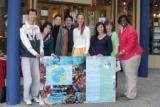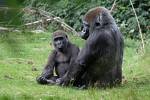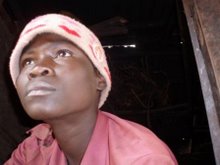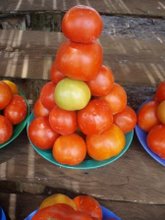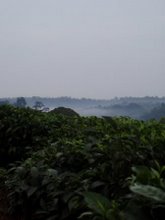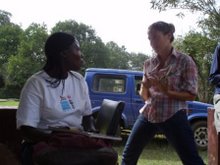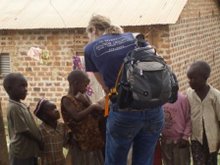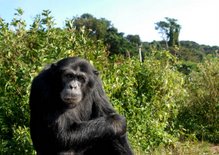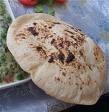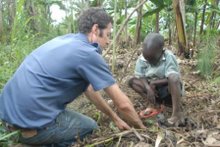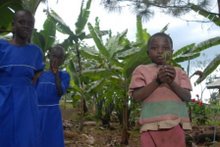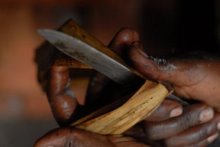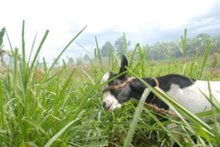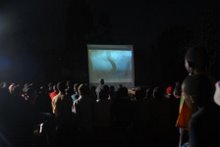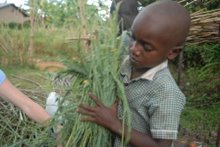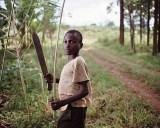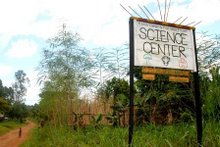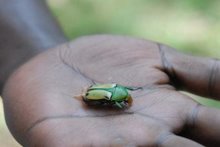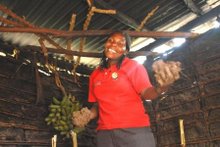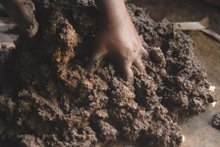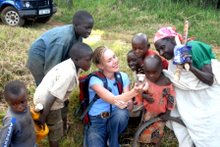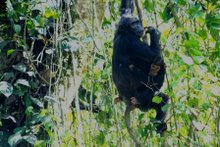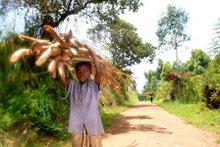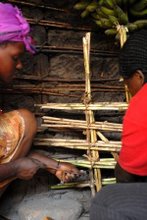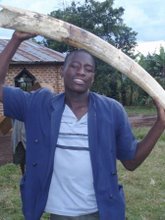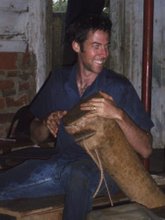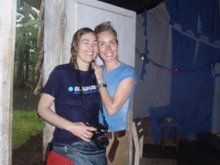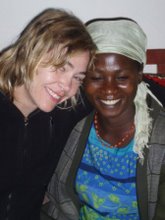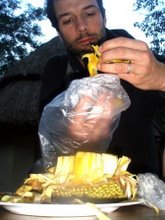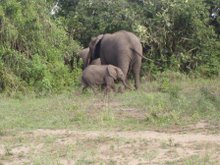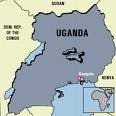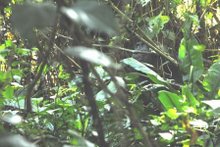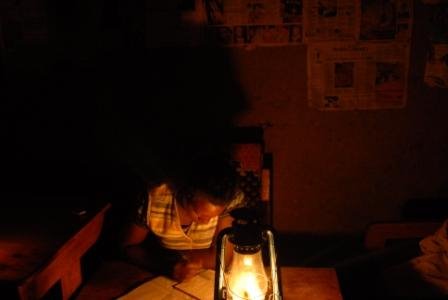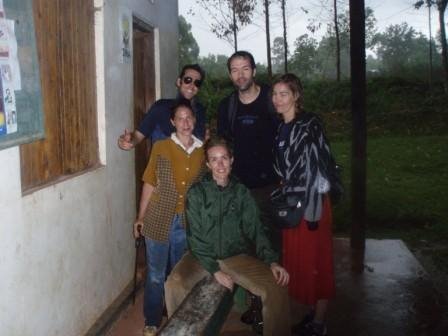Monday, May 14, 2007
Spreading the Word in a Local Way
Other projects were featured from Vancouver, Canada and the Seattle and surrounding areas. We were all invited to share the individual work we have done towards promoting sustainable values.
Large changes in local and global communities are being made, and each started with a small step.
Kind Thanks to the EarthCharter organization for their attention and promotion.
The Monkeychatters also wanted to remind those of you who follow Annie Marie Musselman's photo work, that she has a current show at http://www.pcnw.org/gallery/schedule.php in First Hill, Seattle. It's called "A Delicate Balance." Try to get there--it's great!
Monkeychatters
Monday, April 16, 2007
Leather Hands and Feet
Welcome to Apenheul, http://www.goodzoos.com/Netherlands/Apenheul.htm a park one hour away from Amsterdam by train.
Janine's in town, so she's decided to visit the facility http://www.webshots.com/explore/Apenheul and see what she can learn.
It’s a place like a zoo, only if you want to walk through the park, you get a “monkey-proof” bag at the entrance, because the residents aren’t shy.
Do you know the ape, Washoe? She's bonobo, and lives at Western Washington University. She speaks in sign language, and has taught it to her children. http://www.friendsofwashoe.org/meet_the_family.shtml
Gorillas roam freely here. The recently-imported silverback Gorilla is just getting to know the group ladies this morning. He is young and brash, and pounds his chest to show off a bit. (just a typical teenager). Most of the ladies don't know quite what to think of him yet, but as he is really big and mighty powerful, they keep their distance and show him respect.
Speaking to the gorilla keeper for a while was great. He had been with the animals for twelve years, from the time that he started as a seasonal worker in his teens. He told us that Diane Fossey had visited once, and had invited a number of the keepers to come observe the gorillas with her for a full month in Rwanda. He went, and he said it was one of the best experiences of his life. Uganda is right beside Rwanda in Africa, and the forests connect together in places.
The Orangutan group was large.
Unlike Seattle's Woodland Park Zoo, which has hybrid orangutans (a genetic combination of Borneo and Sumatra bloodlines), these 14 (fourteen) Orangutan all came from Borneo or were born from parents who originated from there. They are a dark red-rouge color, and extra furry.
One orangutan mother we saw had her own child, and had adopted another from a mom that couldn't produce milk. She was hanging out nearby with the two kids wrapped around her hip and head, looking patient. "They are all so calm," Janine said--"do they really like strangers?"
The keeper shook his head 'no' with a smile and responded that he left all the decisions to the chief male, to whom Janine was introduced upon first entering the caging area. "If he doesn't like you, then I go with his decision, otherwise you're ok..."
...whew...
Meerkat, bush babies and other 'half monkey' types share your benches, and stare at you as you eat your ice cream. It's a little unerving at first.
Keepers stand back and look on.
The keeper functions more like a friend in the background rather than a trainer, disciplinarian or even a peer to the primate communities at Apenheul. Each of them explained their jobs, and the overwhelming impression was how much they loved the animals, and loved what they did.
The behind-the-scenes peeks into the facilities took 4 hours. At the end it was evident that this place was really about CONSERVATION. Overall it was a very peaceful spot on the planet (with occasional scuffles over who was going to get the orange slice at lunchtime.)
Included are some of the photos from the day, along with some webshots taken by other people found online. You'll enjoy the cheeky little buggers!
Thursday, April 12, 2007
Homeward Bound
Becka and Michael will be touring the United States from east to west visiting friends and relatives, and being special guests at events surrounding support of the important work we all hope to continue in Uganda. They will return in September 2007 for another year.
Annie and Josh will be returning to Seattle where Annie begins the long and laborous task of developing, sorting, editing and printing photo selections reflecting key moments of the time abroad. Good luck Annie, and good work!
At some point in the future, we hope to share these with all the families, friends, coworkers, and supporters--our special community surrounding this important conservation effort!
Janine returns to Seattle a few days after Annie and Josh. She'll be stopping over in Amsterdam, Netherlands to have the stitches removed from her right knee.
...what, you didn't hear about that?!???#*#*#*#%*
It was the day she and her crew flipped the raft upside down in the center of a class-5 rapid on the Nile. She's pretty excited to see what the scar looks like, and to tell the story to her grandkids...
"Back when granny had teeth," she'll say,
"She was rafting on the Nile River in Africa..." (sounds pretty impressive, eh?). "
"...and here's the scar from the stitches..."
She's already started queries to magazines to see if they will consider articles about the events overseas.
As we wash the smell of African morning campfires out of our hair at the hotel prior to departure, we are reminded of the sights and sounds of a land rich and fertile with a smoky skyline--vibrating with activity. The clothes we bring home have a strange perfume, exotic and warm, making our memories more vivid, and our comfortable beds, indoor plumbing, plentiful food and electricity seem strange and foreign.
Our busy lives will change a little because of the new things we have known and seen.
Monday, April 9, 2007
Divide and Conquer
Annie and Josh have landed near Kampala at the N'Gamba Island chimp facility, and Janine has gone north to the source of the Nile river. Annie and Josh travel home the next day. Safe travels, you two!
http://www.ventureco-worldwide.com/jinja_chimpanzee_project2.htm.
Both facilities are managed by Cam Macleay in Uganda, who owns the “Adrift” whitewater rafting company in Jinja. Janine will be staying at his base camp along the Nile banks for a week and braving the white water to get to Kalagala Island.
Kalagala Island (actually two islands) is the newest facility for abandoned chimps whose parents have been lost to poachers or as casualties of the bush meat trade. We are looking forward to learning about how orphaned chimps are cared for.
It is Easter here, so people celebrate by relaxing the week before and the few days after. That means everything basically stops moving. It's really hit and miss with supplies and chapati. It's a good time to catch up on journals and have a look at the photos so far.
What's chapati? Ugandan comfort food--a round, puffy tortilla made from millet flour and lots of oil and salt, grilled over an open flame. It's completely addictive and incredibly yummy, especially when made in front of you and served warm. It tastes alot like indian naan and sells for a few cents each. Hmmm.
Monkeychatters
Wednesday, April 4, 2007
More Answers
If you are just counting insects alone, it is into the millions--and there are lots that don't have names, and researches are finding for the first time. We average 3-5 bites. We wear sleeves, so when we are treking they climb your pants and bite on the seams..but we are doing ok!
There are reptiles like poisonous vipers (the black mambo is the most popular, and the cobra), as well as snakes with teeth that live in the trees (the brown banded tree snake and the mole snake that has a flat snout, and a local one called the 'eyelash snake' that we couldn't find in a book--he has a row of scales over his eyes that bulge like frogs, and he's electric green.) The eyelash loops himself around vines that wind around tree trunks. When you are in the forest, be careful where you put your hands. They like to perch at shoulder level so they have a good view.
There are whole books on the birds with names like the 'African fish eagle' (looks like the American bald eagles but bigger). There are herons, egrets, swallows, finches, and huge storks--the Uganda national bird. http://www.etg-safaris.com/ug.htm (check out the bird on this safari ad)
There are hummingbirds and colored whatchamacallits and bats that fly around your head at night (we have a family of four that lives in our kitchen that is the same species as the ones in the Woodland Park Zoo nocturnal house). There are over 300 species of birds in Mabira Forest alone, which is near to us. http://www.credit-uganda.com/mabira.htm. This site has birding tours, so you can look at all the colors.
Why do the chimps change their diet everyday?
Chimps don't like to eat the same foods, and sometimes they need different minerals, so they change according to what they crave. If you had to eat peanut butter and jelly every day, eventually you'd get tired of it, right? They like beans that grow in trees and different fruits, bark and leaves, and sometimes insects for protien. They really like ants. Really...the chimps we saw just 'get crazy' over them. The Gorillas did too. We were told that local people eat a bean sauce made with 'g-nuts" (peanuts), and that they will also drop the ants in for flavor and cook them up. Annie and Janine love the g-nut sauce, but without ants, thank you very much!
We have seen 9 kinds of primates so far, apes (no tails) and monkeys (have tails). The chimps we saw would be as tall as your teacher's shoulder if they stood on hind feet, and many times stronger than the stongest man by the time they are teenagers. The babies range from basketball size to knee-high.
Are there schools?
Yes, each village has state schools, and there are private schools in the larger city. Our local schools has about 150 kids. You have to pay for your uniform and your books to go to any of the state schools, but grade school is free. Everyone is charged tuition in middle school, high school and college. For us, it costs about $3,000 for one year to go to middle school, but the people are very poor here. Most kids drop out after grade school to help their parents farm and raise other children, and because they cannot afford it.
When a Ugandan asks you for money, it's usually for a scholarship to continue school. They know that their education is a key to a good job and future.
For some perspective, if a mom makes $3.00 from selling potatoes one day, she affords to feed her family for three days and is happy.
What is your favorite thing about the trip so far?
We have liked so many things so far, but the people here have to be our favorite. They are warm and generous with each other and strangers. They work together as teams, and even old people still contribute to the family. As Americans, we are sometimes a little embarrassed by any complaint, since very few kids even have shoes. We have learned how lucky we are.
We also like matooke (ma-toke-eh), which looks like a banana and tastes like a baked potato. It's served steamed in banana leaves. It's good with g-nut sauce.
Waking up to the chatter of the monkeys is great too--you try to imagine what they are saying to each other, and to watch them play in the mornings--tossing branches and swinging around, you wish you could have so much fun just hanging around in trees...
What's the biggest difference between living there and here?
no bathtubs and you always carry your own tissue. (oh, man, are you serious??? Yep.--back to nature.)
Thank you for the questions!
Monkeychatters
Tuesday, April 3, 2007
Questions and Answers
Until then please enjoy the new pictures we've just added. We all laughed at one very interesting question about the chimps. Someone said "when the fruit hit you on the head, did it hurt?"
Well, it was surprising, but it did not hurt. The fruit was a fig, about the side of a large marble. Since they were looking for the ripe ones, the apes would toss down the unripe green kind, but they only weigh as much as a a bottle cap.
We also enjoyed the questions about insects. You cannot IMAGINE how many insects there are here--mosquitos, beetles, mango flies that lay eggs in your socks when you leave them outside and prefer the tastes of certain colors (Annie's socks with pink hearts were their favorite), ants as big a piece of long-grain rice and that HURT when they get up your pants, grasshoppers the size of your thumb (if you are a local, you catch them and fry them up for snacks), knats, praying mantis, butterflies, and oh...did we mention mosquitos?!?
Monkeychatters
Saturday, March 31, 2007
Mazungus in the Mist
With the encouragement of our sponsors, we've taken a few days to travel to the south of Uganda. The road is the main highway also leading to the Republic of Congo, and the traffic is a little notorious, so we hired a local guide to get us through the rough spots, including the 250 miles between here and the mountain gorillas in Bwindi, and the 12 hours it takes to get there along the dusty, muddy unpaved road through Queen Elizabeth National Park. http://www.kilimanjaro.com/uganda/qenp.htm
This park joins Kibale and extends further to the south.
We're not kidding when we say this road had potholes. In fact, some were hip-deep on an adult, and we all felt like jello by the end of the day. We were unable to get out of the car for various reasons until the main part of the trip was completed, but mostly due to the cape buffalo, lions, african kab, waterbuck, wild boar, hyena, elephants running amok...you get the picture--lots of animals. You can't just stroll down the road in rural Uganda--you'll be someone's dinner.
Bwindi Forest was incredible. Steep mountain peaks hovering in clouds, breezes cool and brisk, lush green mist with everything growing on everything, and lastly, the gorillas at the end of a grueling 3 hour hike on mountain switchbacks. We came face to face with the gentle giants almost hunted to extention less than 30 years ago, and it was a life-changing experience. We sat among them for an hour as their children played, the silverback looked on with wary interest at the white monkeys staring at his family. They are so like us. Looking into their faces and seeing the intelligence was beautiful.
After two nights in the dripping, vibrant freshness we headed back towards Kampala, stopping at a Safari Lodge on the way posted with armed guards. (So close to the Congo, it is necessary for tourist safety, and to keep we Americans from wandering down the road to far into imminent danger). Members of the Ugandan Wildlife Authority also stay with us there.
We saw the hippos the following afternoon, waddling and eating, soaking and spraying, yawning and yawning and YAWNING from the cool water of the nearby lake.
We all wanted to jump into the cool water from the boat--into the channel that connects Lake Albert and Lake George within the confines of the park. The people from the fishing villages lined the banks, and looked like they were having such a good time bathing, washing clothes and filling bottles of the wet stuff--but we couldn't. Unfortunately the water bodies in Uganda have a snail larvae that burrows under the skind and gives foreigners a disease called schistosomiasis (Belharzia). Areas with reed beds, stagnant water, and/or high human use are the most likely places to catch it. The disease can last for up to 20 years, and as locals don't mind, few Americans can learn to be okay with the idea of worms mating in our bodies until our brains turn to mush. Yeah--so, no swimming for the monkechatters.
However, we saw over thirty species of birds, and crocodiles sunning themselves with open mouths--some 14ft long at least. The cape buffalo sat in the shallow water and stared at us as we floated by, and some moved if we came to close. It was like the Jungle ride at Disney--but much, much better!
We left for Kampala the next morning. After 9 hours of the Bwindi-Congo road, we arrived in the capital city where, as far as we can tell, the horn is the only form of government. Cars all converge into and intersection at once, facing off and honking. Instead of waving each other on, they just honk...for a while.
If you have a bigger horn or a slippery driver (like the mutatu taxi drivers...the white mini-vans with people, chickens and luggage streaming out all windows and over capacity by at least 6 people) you seem to travel faster from place to place.
There is also the motorcycle taxi, called a bodaboda--the cheapest way to get anywhere, and the most sure way to land in the hospital for their penchant to cut through the space between car bumpers stacked in a waiting line. If chosing to ride on a bodaboda, you learn to say to the driver sternly 'Sir, if any part of my body even slightly grazes an object, YOU DON'T get paid, understand?!?!?" sometimes you get lucky and they do pay attention...
At rest in a Kampala hotel with running water and a comfy bed (we are all so shocked) we hardly know what to do with ourselves. We may actually have a cold softdrink...and ice (such luxury) before we head back south to Kanyawara Village. The girls took long baths and then jumped up and down on the beds.
Monkeychatters
Basket Weavers
The Batooro Women's Guild collects products in a small shop in the central area of the village. Baskets in all sizes are made with grasses collected from local fields, and some are made from reeds which are colored with vegetable dye with traditional patterns woven within each piece.
Some have lids, and some do not. These baskets have been used to store food and spices for generations in the village. Each tribe has a distinct variation in technique.
Beads made from rolled recycled paper and glue are strug together in necklaces and bracelets of vibrant colors. We even see some wax beads that are from Kenya--traded to the locals by someone passing through.
There is a bird here called a black-headed weaver. http://www.mamarazi.com/uganda/gallery02.shtml
The trees hosting the small straw nests these birds build are heavy with the weight of the straw ornaments, each a hollow little nest the home of a mated pair. An average tree can have hundreds of nests.
These birds never rest. They are up early, to bed late, constantly collecting, threading, checking in with their community. It reminds us of the Ugandan people, who are much the same. Even the children view work as a pattern of life, as much a habit as brushing teeth in the morning. We have yet to meet someone who does not work very hard every day.
Monkeychatters
Rain? Let's Plant Trees!
Will we have electricty or not? Who knows? It really depends on the guy who decides to flip the switch somewhere along the line. If he's got something to do that day, then we spend two days in the dark with flashlights on our heads holding our wax candles.
We have been waiting for the first rains to put the first seedlings of the year in. These plants will grow to over 4 feet high in one year, and be cut for firewood, and the leaves stripped for livestock food. Rainwater is collected in huge black tanks outside the huts. It runs from the tin roof over to the cistern, where a faucet at knee-level serves the campers. We can turn the faucet on to get the water we're going to boil.
If you'd like to take a shower, you have to depend on the guy at the park turning on the pump that takes the rainwater to the top of the hill and sends it to your local shared showerhead. He could decide to come to work today...or not...whatever. Nobody seems to get flustered, so we just shrug our shoulders, and grab our cups. We are now experts in the cold 'cup shower' taken in the early afternoons. Trust us, after a couple of days of no running water it's the best experience in the universe.
Speaking of the rains, they are certainly here. They came yesterday, our first planting day.
We first cut a set of year-old seedlings outside the Science Center. These trees have been grown as an example so the villagers can see the potential of the wood source. They surround the outside of the property, and take up little room among the other plants such as bananas, potatoes and various agricultural crops. (One of the difficulties outsiders have with encouraging tree growth in Africa is that the people need their land to raise food for their families--this tree is great because it grows fast, creates a fence around the planting area to keep out wandering cows and goats, as well as continues to provide a much-needed wood fuel source.)
About 20 kids showed up between the ages of 5 and 13. They all joined in the process, In fact, most of the cutting was done by boys who were 6 or 7 years old, and using a machete (panga).
(Check out the photo of the tool.) These kids have been using this tool in the fields since they were 4 or 5, so they are much better at using it for cutting than we are. They were so excited and proud to learn what part they were playing in conservation.
So we planted 4-inch seedlings, and no sooner than we had put the majority of them in the ground, than an enormous storm came up. We crowded under eaves, amazed at the amount of water dumping all around us and laughing--waiting for it to stop--that is, we waited until the wind shifted, it started HAILING, and there was NO DRY SPOT left to be found. Waterfalls ran over our shoes.
Dazed and soaked, we looked around. What was that noise? Who was calling? From where?
The local kids were leaning out of the church door at the waist trying to get our attention. They were waving to us from the open doorway. Without hesitation, we dashed for the opening! For the next 30 minutes, the kids played drums, danced, and they hosted us with fresh bananas as we sat on the wooden pews and dirt floors of the rustic building wringing ourselves out. It was a completely African experience--thunder outside and thunder inside!
When the clouds broke it was evening so we geared up and headed back towards the camp. The black and white monkeys were calling to each other--they too were glad that the storm was over.
We expect this every day now, usually at the same time. The rains are here, so we'll be planting trees!
Monkeychatters
Medicine Woman
Today was exceptional, as we visited with the oldest lady in the village. She is 87, and lives in a small hut made of mud and homemade brick with a dirt floor, as most do. The special thing about this lady is that she was recently given a bite on the foot by a deadly viper, and survived because she is the village healer. She treated herself with herbs, and the bite was not fatal. People from as far as 50 miles away come for her advice. (and that's a big deal, because nobody has cars here, and it's a hot walk!)
While we were there, 4 separate groups came and went, looking for advice on all manner of ailments. The lady had the kindest face you've ever seen and all manner of dried whatchamacallits hanging from the ceiling of the kitchen hut, including hair from pigs, lots of dried chicken parts, and something like mushrooms. Most people here prefer witch doctors to trained medical doctors.
We learned that the teenage girl living with her was her granddaughter. She had been there since she was 2 years old. The girl's mother died, as well as 6 other children belonging to the elderly healer. As we are learning, this is very common in this village. The older generation is taking care of the youngest generation, and the middle section has died out due to the AIDS virus. There is a stigma attached to testing the blood, so not many do it. It the virus is diagnosed, there is rarely the money to afford the expensive medicines, so by the time folks go to the medical doctor the disease is so severe that death is the likely scenario.
Tradition also plays a part in the AIDS crisis. Locals tell us that in the Batooro tribe, if your brother dies, you are supposed to take on his wife and children as your own. Until AIDS this was a workable solution, but supposed the brother died of the virus, then the wife likely has it, gives it to the new husband--you get the picture. There are lots of orphans in this community. To change it is to change a tradition thousands of years old...and it's almost an impossible task.
On a lighter note, we got some terrific photos of this special old lady in action, and she enjoyed our gifts of Cadbury 'sweeties" (that's candy--but there is no word for 'dessert' in the local language) we brought along.
The stove we made today was a modified version of a former design. This family had very little mud/clay for packing around the bricks, which form the base of all the stoves. They had very few bricks, as they were extremely poor. Normally it takes about 30, and they only had 14--so we substituted a combination of dried banana stalks on either side of the front--like a hearth on a fireplace (check out the photo of the stove on the Kibale Wood Fuel Project website). We tied the stalks together with banana leaves to make a series of squares, then stuffed the squares with mud.
If it sounds like we spend alot of the day making mud pies, you'd be pretty close to right! Just TRY to keep your fingernails clean here. It's not possible!
Monkeychatters
Friday, March 23, 2007
Finding Chimps
Not many people from the village ever go into the forest, even though it is at their back door. Mostly, the locals except gather wood at the edges. Part of the Kibale Wood Fuel Project's goal is to create a relationship between forest and village, so villagers can be advocates of their own natural resource.
We spent most of the day deep in the forest, looking for the chimpanzees. Our guide used to be a poacher, but the Uganda Wildlife Authority (UWF) hired poachers as patrolmen a few years ago to protect the forest instead, which was a very smart thing, as they know the forest better than anyone. Three (3) hours into a grueling walk through swamp and up hillside, down ravine and around vines that had long ago strangled out the host branches by winding around them hundreds of times, we came to a clearing. The guide went silent. “Now, he said—they are coming!…make sure you are standing up!”
Out of the shadows of the deep trees to our right they came, walking on knuckes towards trunks. There were 30 animals, all moving toward us—all around us. “Stand up!—let them see you, “ he said.
They took slight notice of us and starting to climb, making noises in their language. They grunted and screamed, scooted up the nearby trunks, everyone at once, it seemed—a collective noise in the dim light that made the air around electric. It was scary and amazing at the same time. All of our hearts were beating so quickly!
Above our viewpoint on the forest floor was a fruit tree. It was in this tree the scouting team sat, calling to the others ‘food here, food here.’ The mothers held their babies closely and ascended with one arm. The young males in the group were grumpy with each other, displaying their bravado and shaking the branches. Then everyone was above us, and the forest floor was quiet except for the 2 inches of dry leaves, and the shells of the figs, half-eaten, that the apes let fall. More than a few hit us right on the head.
These apes are one of a few groups that are allowed to interact with people. They number about 30. There are two other groups about the same size that are available only to researchers. The rest—roughly 1400 are left completely alone to live deep in the forest.
After one hour a scout ape called again from a location close by—more food had been found. Chimps change their diet everyday, depending on what they want to eat. Some days its leaves, some days monkey (the Red Colobus is a tasty treat for them), and today the menu is figs! Onward!
In another rush all the branches around us started to shake and apes began dropping from the sky, moving quickly toward the sound of the food call. We were as close as 20 yards from one as the group passed, yelling over their shoulders at the next shift coming behind them aiming for the same trees. They had a complete conversation around us, including the information to the new group that there were people here, and that we were not the harmful kind.
It was then our time was up—by law we can only spend one hour with the animals, then we have to leave them alone. We backed out slowly, careful not to disturb their activity. They will feed, then build their night nests and go to sleep—a different place every day.
What an amazing time! We now understand more completely why this forest must be protected. By planting trees in the village outside the forest boundary, people will not need to chop wood from inside the forest and destroy the food and shelter of these animals.
Village Stoves and Cow Dung?
You're kidding, right? Nope.
Our destination this morning is a house at the far end of town. It takes only 30 minutes to walk there from our place, being careful to greet everyone on our way. Greetings are very important to Ugandans, and these people in particular.
Margaret is the one who speaks the language, is welcomed into to the houses, and she yells at the passerby ‘do you have your new stove yet? When should I come by???” We are her employees for the day, so she helps us with respectful greetings. Margaret is intelligent and worldly by Uganda standards, and as all Ugandans, smiling most of the time. We make our way to the Science Center (museum) established by the Kibale Wood Project--Margaret is employed by the project.
In the museum yard sits the starter plants for the fast-growth trees. (Acacia, other local varieties) The rains came this morning very hard and fast so we will be planting soon. Heavy drops on the tin ceiling of our rooms—to the point where it sounded like a freight train above us started before dawn. The wind circled through all the rooms through the window screens, and the temperature dropped 15 degrees in 10 minutes. The sounds of the animals stopped, then presently, started again with a different song—now the sound of insects and frogs singing.
Tonight we host dinner for the research students. It is handy to have this community here--as somebody has a bird book, another person has sugar, the next has a flashlight. We are developing relationships with our neighbors too, many of whom also work in the villages when they can.
A Baboon is in the Living Room!
Baboons are an intregal part of the dish-cleaning process. We have a group of 10 or so that hover around our campsite just outside the clearing where our hut sits. When dinner is finished we simply leave the plates out back, and find them in the morning strewn about the clearing completely clean.
We have taken to asking each other prior to using any utensils ‘is this the baboon knife, or the clean one?” All baboon knives means it’s time to do the camp dishes.
The Ugandans liken them to dogs, and they bark in a very similar way, but are much more mischievous. We sat Wednesday afternoon at the edge of our clearing listening to the baboon chat in the waist-high grasses just 20 yards away. The dads keep the kids on their backs, and sometimes, we are told--will put them through the bars in your windows to steal your bananas. We keep our shutters closed when we are out, with the bolt turned!!
This morning however, we had a shock. Our hut is a small concrete building in the shape of a square with a cement floor. If you can picture the square, then divide it in half. One half is bedrooms, the other half is a thick hallway, where we keep our supplies stacked on tables. This side has a door opening on each end--one toward the kitchen and one toward the forest.
A quick brown flash this morning as we were standing in the bedroom area made us all run out into the hall yelling. Tail waving left to right and looking at us over his shoulder, a baboon had run into one of the doors, picked up a packet of Emergen-C Bone Health (vitamins) from one of the tables, and dashed out the opposite door. I swear he was laughing. We all realized that we had been yelling after him and then stopped and laughed too. A baboon was in living room. Now that's just wierd.
Florence and First Monkeys
TUESDAY
Florence arrived today. She’s a lovely Ugandan woman in her mid twenties.
She is making bread for us, a local flatbread made from flour, baking powder, salt and water. It looks a bit like a tortilla, but is tougher. Of course, it's fried, but then in Uganda--what's not?
We have been eating alot of fruit and peanut butter sandwiches.
She has also agreed to wash our clothes, as we were not doing very well with that and always seem to have dirt under our nails and dust in our ears from the towns. For her, it is great to have the work, for us she is our angel.
We would not have time for our jobs here if we had to wash clothes every day. There is no washing machine, so she uses a washboard and basin, and wrings everything by hand. Then she hangs it on a line to dry, where the insects lay larvae in them, so each piece (even underpants) has to be ironed to put an end to what’s living inside. It’s quite a process.
She has also agreed to help us with the water situation. We boil 2 gallons everyday on a kerosene stove. She has very white teeth and a peaceful smile that lights up easily. We notice this because she is constantly laughing at us making mistakes. I can only imagine the stories she must be telling...
We took a primate walk this afternoon that took us two hours into the forest. All the vines are woven around trees and roots, and the ground is rough. Butterflies move about constantly, with 20 to 30 in every glance…they are everywhere.
A person tracks monkeys by what they leave on the ground and the smell in the trees by the trail (monkeys don’t bathe, it’s not too tough). And come across them in the last hour jumping from tree to tree. We found two different types, the Mangabee and the red-tailed monkey.
These groups will often live close to each other and share the same fruit. We watch for an hour while they play, eat, chase each other, and occasionally stop to stare at the wacky humans on the ground with binoculars. On the way back, we stop to look at where elephants decided to knock something over, and heard one very close by. We all FROZE! We have been told if they break toward us we are to RUN FAST, because they would certainly trample us.
Some of the field assistants at our research station who have actually BEEN chased have told us that the thing to do is to drop a jacket or backpack and head for the nearest tree like the chimps do. The elephants will then toss your backpack around for a few minutes and then leave. The research assistants suspect that the chimps play tricks on elephants from the trees, hence they are pretty irritated with them as a whole, and we look enough like them to get on their last nerve.
Tonight when we returned to camp a group of black and white monkeys greeted us in the trees overhead. Apparently we have good fruit in our area.
Exausted, we fell into bed serenaded by the forest acacia, deep monkey hoots and all manner of buzzing, snoozing, flying, crawling and multi-legged friends. We are becoming more comfortable with the foreign voices and feel lucky to be able to see all of this.
Wednesday, March 21, 2007
Hot Soda Pop and Bongo Drums
We have arrived in the forest! The research station sits at the jungle edge, a group of huts housing students from the local university, and PhD students studying everything from butterflies to dung beetles. (Yes, it's a beetle that prefers to lay its eggs in refuse. Look at it this way, if he fails, he's fertilizing!) The research community is from Holland, Scotland, Asia, etc. We are the only folks from the United States. We put our tired selves to bed last night after hanging the flour and peanuts from the walls to protect them from the critters.
Sunday dawned hot. Since we were being introduced as new members to the village, it is proper that you go to a town meeting, or a church service. It’s all the same. The word is out about you, so you might as well make a good impression. Today we put on whatever we had that resembled a skirt and went to church. (Ok, Josh wore pants). Then we walked the 20 minutes to the service.
The building was cool inside, made from the local red mud bricks with the coating of sand and cow dung on the finished walls. They are painted white. The floor is red packed dirt. All the ladies are dressed in their finest colors and headscarves. The women and men have benches, and the children sit in front of us on locally woven mats. We try to sneak in the back, but it’s not going to work, as a lady named Harriet in a white shirt, skirt and tie escorts us the place of honor on the front row directly behind the children. We have our own translator, a man with broken English that we barely understand. It is a great honor to have us here, and a rare treat to have the sermon translated into English. We nod and try to pay attention.
A choir of ladies dresses in the same uniform stands behind the pastor, bible aloft, who presides behind a rough-hewn alter -a dirt-smeared structure of wood with a group of field flowers in a cracked glass vase. Some hymns we recognized *Amazing Grace in the local tounge (Rutooro) is one.
The fusion of traditional dance and chanting rose to a fevered pitch several times during the next two hours followed by full 5 minutes of everybody mumbling their own personal messages to god. It was incredibly moving. We all shed tears of amazement. The trio of bongo drums continued for the last hour, dust filled the room, the children in front of us stood on their feet and showed us how it was done, and we clapped and swayed with the music too. What a Sunday. The photos are forthcoming, but computers are primitive here, Internet slow, and it will likely take one hour just for one blog posting. We will have to save the photos till later.
The church is the main sponsor of the Kibale Wood fuel project in this area. It is important for outsiders such as us to work within established community groups like churches and guilds, and this is the local sponsor in Kanyawara Village.
Nobody does work in the fields today. It is the day the women have off (men don't farm). To the extent that they can, females wash, cook, and farm other days, but not today.
This allows the women’s group at the Science Center to meet on Sundays. They create crafts to earn money for their village, and sales go for educational scholarships for the village children. They also find the support of other women helpful. Ugandan women get married very early, sometimes at 13 or 14. Older women have as many as 10 children, and men have more than one wife sometimes, depending on the household income. Many of these women have adopted children of family members and friends who have died from AIDS.
Since the rainy season is just now beginning, tree planting is waiting for a real soaking of the ground. We hope it will happen this week, as the rains seem to be starting. In the meantime, starter plants sit under a shelter at the Science Center growing slowly and waiting to be transferred. They surround us on both sides as we sit on the grass in the small yard, barely 5 inches high, later that afternoon.
An old man walks by and stops, shaking a stick at us and yelling in anger. We are mazunga, (white) and foreign. We have taken animal bones and put them inside the building, sacred bones that hold the spirits of the departed, often medicinal by tradition. Villagers are very superstitious, especially the old ones. In fact everyone uses pet names for each other, in order that the evil spirits cannot locate them.
Every child is given when he/she is born three names. One is the birth order. One is a real family name, and the last is a pet name. There are twenty or so. Because we will be with the villagers and they wish us luck, they have give us all names. Annie is Abooli (cat), Josh is Aralli (lightning) and Janine is Atoki (traveller or spirit). We can't choose our own, but we like what we have been given.
Annie (Abooli) will be teaching a watercolor class this afternoon. We will wait for her to finish, then start setting up for the weekly movie night. Josh is making a soda pop run to the store! A three (3) minute walk away and he returns with hot Fanta orange and hot Pepsi Cola. It's perfect! We are learning how to better appreciate small things in Africa.
So, we have discovered our job here. It is not only to understand what this project is about, but to become a part of it. We always knew we would be bringing back pictures of the progress, but we are discovering the opinions of the locals. This project is about trees and solar ovens, yes. It is about preserving the forest and the primates and wildlife contained in it--yes. But it is about empowering people to change their lives. Our lives are changing in the process, as we begin to understand what it means to them.
We'll be stopping now, as the hard thunder has begun and the power is going out in a few minutes.
Monkey chatters
Saturday, March 17, 2007
Touch Down
We arrived safely last night, and stepped out onto the tarmac where blustery winds and 70-degree weather greeted us. The air smelled wonderful. Very GREEN.
As we walked toward the metal shelter suspended with poles (along with 200 other passengers) all of the power in the airport went off. It was pitch black, with only the sound the locals in the air laughing...one lady in front of us said "welcome home..."
Power outages are common here.
When illumination returned a few minutes later, we noticed the thousands of mosquitoes hovering around the overhead lighting. Indeed, welcome to
Our visas were purchased promptly and our names written in a great book for receipts, and our luggage came out on a mini-turnstile. A driver we had arranged was waiting for us outside the unloading area with a sign that said "
His car deftly navigated the parking lot, an unorganized area inside a fence with pitted asphalt with potholes and the matatu (minibuses) competing for space in the driveways. Then onto the main paved road we shot--driving in the dark, forget about a speed limit, on the left side of the road.
By the time we reached the lighted valley where
Peter unloaded our bags and gave us a smile. "Is it safe here?" we asked.
"Yes, relatively--it's
We took that as 'better hang out around your hotel, you nutty Americans."
So we did.
This morning the sun rose warm through the hotel windows. The city below was bustling and noisy. Our
We have spent the morning in
Overall, we are finding that everyone here is very friendly and helpful, that some people want to speak to us just to practice their English! By this afternoon we should be getting acquainted with the Research Station that will be home, and by tonight--the Irish among us will celebrate St. Patrick's Day together. The children here are amazing, and if you ask permission, local mothers are happy to have you take their picture.
All the best to everyone at home. Everything here is colorful and vibrant--fabrics, people, sound and noise. We are looking forward to a good trip.
We will be in touch as soon as possible--with pictures if we can.
Monkeychatters
Friday, March 16, 2007
Pastries in Amsterdam
Ham and cheese...(croissant kaas, paid for in Euros, please!). I'll have another.
We've just arrived in Amsterdam, the mid-way mark of the trip. With 8 (eight) more hours to go, we have a three-hour layover and have made ourselves at home in the airport for a bit.
We have determined after not much discussion and limited viewing of the landscape as we arrived, that Holland is FLAT! Did you know that part of the land used to be the ocean?
So you know what Holland (the Netherlands) is famous for? Here's a hint: http://www.myphotographs.net/holland/holland10.html
Our route took us over the southern tips of Greenland and Iceland, over the North Sea and down through the most beautiful clouds! We flew into the night, and as we arrived we saw the European sunrise--reds, yellows, bright pinks and oranges. It is morning here.
Onward to our final destination! Thanks for following along. We will try to write again when we arrive.
(Monkeychatters)
Monday, March 12, 2007
Jambo Uganda!
So we are saying "Jambo" to Uganda this week!
http://wikitravel.org/en/Uganda
Passport? Socks? Compass? Guidebook?
The photo essay of Kanyawara Village takes off
this Thursday, March 15, 2007. http://blueearth.org/projects/kanayara/index.html
Track our flight status http://www.timeticker.com/
Leave: 2pm PST on Northwest oo34 March 15.
Arrive: Kampala, Uganda (EBB) at 9:05pm. March 16.
We'll stay in the capital city of Kampala our first night. http://www.ugandatourism.org/maps%20of%20uganda.php.
After a big yawn and stretch on the morning of March 17 and coffee for our jetlag (NO Starbucks?!) we start the trip to the fabled "Mountains of the Moon" and Kanyawara Village outside the Kibale National Forest. http://home.debitel.net/user/nitsch.l/exsn/eafrica/gall_01.htm
When we are having breakfast, what will you be doing?
Michael Stern is driving, (thank goodness!) as Ugandans have the reputation for driving really fast AND in the center of the road. He and his wife Rebecca are Americans, friends and scientists that work with the Kibale Wood Fuel Project. http://www.chimp-n-sea.org/
They will be guiding us how to shop for food and supplies in Fort Portal.
http://www.ugandatourism.org/maps%20of%20uganda.php.
There are lots of things in Uganda to eat that can make us sick, so we need to be cautious. Westerners can only drink bottled water, or water that has been boiled for 5 minutes. We cannot eat any lettuce! In fact everything needs to be cooked, except for fruit we peel ourselves. So we'll buy canned goods for the camp.
What can you imagine that we also have in our bags? mosquito nets? medicine?--pills to prevent malaria, a dose of antibiotics? How should we dress? It's the start of the rainy season, so we are bringing our ponchos! What's the temperature in the forest?
Here's where we will be for the next two weeks:
Makerere University Biological Field Station (MUBFS)
http://www.usu.edu/mubfs/frames.html
Annie will be taking along lots of heavy cameras and equipment like batteries, lights and film, and all of it in extra-special waterproof containers that look a lot like Ziplock bags. She will need more luggage space than Janine! Josh Uhlir, Annie's husband and also a writer, is coming to help out.
Send us any questions you might have, or messages for the kids here. You can write to the blog, or send personal messages to kennedy@primateplay.com.
A special thanks to all you superstar sock-hopin' kids at Valley School in Seattle, Washington.
We will keep you posted on our progress whenever we have electricity and Internet.
Speak to you soon! (Monkeychatters)
Annie, Janine and Josh
